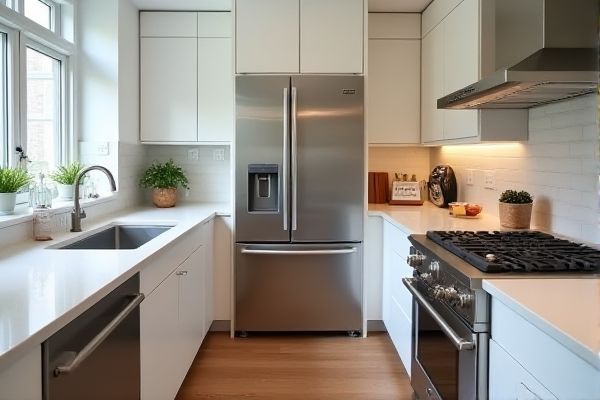
Counter-depth fridges offer a sleek, built-in look that aligns flush with your cabinets, saving kitchen space without sacrificing much storage capacity compared to standard-depth models. Discover how each style impacts your kitchen layout, efficiency, and design by reading the rest of the article.
Table of Comparison
| Feature | Counter-Depth Fridge | Standard-Depth Fridge |
|---|---|---|
| Depth | 24-30 inches, aligns with counter depth | 30-36 inches, extends beyond counters |
| Width & Capacity | Smaller width, reduced storage capacity (10-18 cu.ft) | Larger width, higher storage capacity (18-26+ cu.ft) |
| Kitchen Integration | Sleek, flush fit with cabinetry and counters | Protrudes, can disrupt kitchen flow |
| Price | Higher cost due to design and features | More affordable, wider range of options |
| Accessibility | Easier access, no door overlap into kitchen space | Doors extend into room, may hinder movement |
| Installation | Requires precise measurements for customization | Standard sizing, easier installation |
| Energy Efficiency | Often more efficient due to smaller volume | Varies, generally less efficient for larger sizes |
Introduction to Counter-Depth vs Standard-Depth Fridges
Counter-depth fridges are designed to align closely with your kitchen cabinetry, offering a sleek, built-in look that saves space and enhances aesthetics. Standard-depth fridges typically provide greater storage capacity with dimensions extending beyond the cabinets, making them ideal for larger households needing additional food storage. Choosing between counter-depth and standard-depth fridges depends on your kitchen layout, storage requirements, and style preferences.
What Is a Counter-Depth Fridge?
A counter-depth fridge is designed to align closely with the edges of your kitchen countertops and cabinetry, providing a streamlined and integrated look. Unlike standard-depth fridges, which typically extend several inches beyond the counters, counter-depth models reduce the appliance's protrusion, saving valuable floor space and enhancing kitchen flow. This design prioritizes aesthetics and space efficiency without significantly compromising storage capacity.
What Is a Standard-Depth Fridge?
A standard-depth fridge typically measures around 30 to 36 inches deep, including the door handles, making it a common choice for most kitchens due to its larger storage capacity. These refrigerators extend beyond the edge of standard countertops, offering more interior space but potentially disrupting kitchen flow and aesthetic lines. Your decision between this and a counter-depth fridge should consider the balance between maximizing storage volume and maintaining a sleek, integrated kitchen appearance.
Key Design Differences
Counter-depth fridges have a shallower depth, typically around 24 to 30 inches, allowing them to align closely with kitchen countertops and cabinetry for a streamlined appearance. Standard-depth fridges usually measure between 30 to 36 inches deep, providing more interior storage but protruding beyond the counter edge. The design trade-off involves balancing aesthetics and kitchen workflow with storage capacity and user convenience.
Space and Capacity Comparison
Counter-depth fridges offer a streamlined profile that aligns flush with cabinetry, saving valuable kitchen floor space but generally provide 10-20% less internal capacity compared to standard-depth models. Standard-depth refrigerators typically range from 30 to 36 inches deep, delivering greater storage space ideal for larger families or bulk shopping, with capacity often exceeding 25 cubic feet. Choosing between the two depends on balancing design aesthetics and space efficiency against maximum food storage needs.
Aesthetic and Kitchen Fit
Counter-depth fridges offer a sleek, built-in appearance by aligning flush with cabinetry, enhancing kitchen aesthetics and creating a spacious, streamlined look. Standard-depth fridges protrude beyond cabinets, providing increased storage but potentially disrupting kitchen flow and visual harmony. Choosing a fridge depends on balancing design preferences with space and storage needs to optimize kitchen fit.
Energy Efficiency Considerations
Counter-depth fridges typically offer better energy efficiency due to their smaller size and reduced interior volume, which requires less energy to cool compared to standard-depth models. Your choice between a counter-depth and standard-depth fridge can impact your energy consumption and utility bills, as standard-depth fridges often have larger capacities but higher energy usage. Selecting an Energy Star-certified model within either category ensures optimal performance and energy savings.
Cost and Budget Factors
Counter-depth fridges typically cost 20-30% more than standard-depth models due to their sleek design and space-saving features. Your budget may need adjustment if you prioritize a streamlined kitchen look, as standard-depth fridges offer more storage capacity at a lower price point. Choosing between the two depends on whether saving space or maximizing value is your primary goal.
Pros and Cons Overview
Counter-depth fridges offer a sleek, built-in appearance by aligning with cabinetry, maximizing kitchen space and improving traffic flow, but they generally provide less interior storage capacity compared to standard-depth models. Standard-depth fridges often have larger capacities and more affordable price points, making them suitable for bigger families or heavy storage needs, though they can protrude beyond cabinetry and disrupt kitchen aesthetics. Choosing between the two relies on balancing design preferences, storage requirements, and available kitchen space.
Which Fridge Depth Is Best for You?
Counter-depth fridges offer a sleek, built-in look that saves space and enhances kitchen aesthetics, making them ideal for smaller or modern kitchens where seamless design is a priority. Standard-depth fridges provide more interior storage capacity, perfect for larger families or those who need to store bulkier items regularly. Your choice depends on whether you prioritize space efficiency and visual appeal or maximum storage and functionality.
 homyna.com
homyna.com